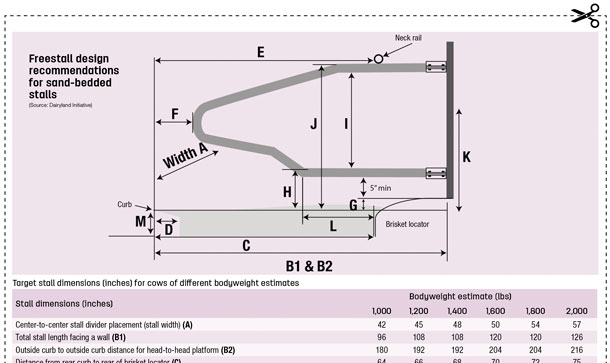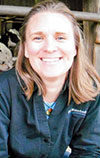Do you remember the last time you banged your head on something? Think of a time when you really gave it a whack. What was it?Where were you?
Will you be darn sure you don’t do it again next time?
Would you change your posture, location or frequency of being put in that situation again?
If you could move the object out of the way so you didn’t hit it again, would you?
If you could yell at someone to make the change for you, would you?
Now ask yourself this question: Would your cows ask you to move their neck rail or shoulder bar if they could?
In a freestall, a cow must modify its rise and fall motion by stepping backward instead of the natural forward step it would take in a pasture setting.
Cows can and will make that compromise and step backward in the freestall, but only when all other conditions in the stall are ideal – proper lunge area, proper stall width, proper positioning of the divider loops, neck rail and brisket locator. Slope and curb height also play a role in comfortable stall design. It’s not just one thing. You have to get a lot of things right.
We want an open stall with a loop open from side to side with enough lunge space for the cow to propel its weight forward and up. Yet we come up with new products or different ways of doing things because something else is wrong.
The neck rail (or shoulder bar, as some may call it) is supposed to position the cow while standing in the stall. It is a visual and physical barrier to moving too far forward before lying down and after rising. Too often, neck rail placement is used as a Band-Aid for a stall design flaw or a stall management issue.
Fortunately (and unfortunately), most systems allow you to tinker a bit with the measurements. This allows for customization based on your herd’s needs, but it also represents a moving target for finding the right measurements because the placement can have a great variety in the barn or throughout the pen.
If you take the time to watch your cows, study the group’s size, look for large cows and the smallest cows, then consult with a few resources to review recommendations, you can often make minor adjustments that can make a big difference to the stall comfort for your cows.
Click here or on the image above to view it at full size in a new window.
A Band-Aid for bad stall design?
Sometimes neck rail placement is trying to compensate for another dimension that is incorrect. For example, if there isn’t enough lunge space in front of the stall or the loop doesn’t provide enough side lunge space, a producer will move the neck rail forward or back trying to find the right place for the cows. But that can do more harm than good.
Whack! Are your cows hitting their necks because they do not have adequate side lunge space? Is freestall divider design contributing to neck rail problems?
If the neck rail is placed based on where it provides the most stability for the stall dividers, is that really the best place for the cow?
Whack! Have you crowded the cow’s stall by placing the neck rail too far back in the stall to provide stability for the divider loops?
Depending on the average size in the group of cows, the neck rail should be located 36 to 52 inches above the stall surface with a horizontal placement measuring from the curb between 60 and 72 inches.
This horizontal and vertical pair of measurements can sometimes only be achieved in a newly constructed barn. Sometimes the stall height is fixed and cannot be raised or lowered. In this instance, the diagonal measurement from the rear curb to the neck rail is recommended to be 70 to 89 inches.
If you are facing a challenging renovation, work with a dealer or company representative who is willing to ask you thoughtful questions about stall design that works for your situation and will provide the most comfort for your cows. It will take some elbow grease and time, but minor adjustments are often able to be made that can improve cow comfort in the stall.
A Band-Aid for bad stall management?
The University of Wisconsin Dairyland Initiative advises that “in stalls with mattress surfaces, the correct neck rail location is directly above an appropriately located brisket locator … so the majority of cows in the pen can stand squarely on the stall platform with all four feet, while manure lands in the alley.”
Whack! Is the brisket locator too far forward in the stall, allowing the cow to scoot forward when it’s lying in the stall and hit the neck rail when the cow rises?
A common problem the Dairyland Initiative cites is “the neck rail [is] too near the rear curb in mattress stalls with the belief it keeps the stalls cleaner. This is counter-productive as it reduces stall use and promotes perching in the stall (standing with rear feet in the alley).
When attempting to lie down, cows have to stand across the stall and, from that position, may end up lying diagonally and soiling the stall bed when lying.”
However, just the opposite recommendation is made for deep loose-bedded sand stalls.
With the “neck rail located too far forward in a sand stall, the cow has room to stand diagonally across the stall with its rear feet inside the raised rear curb. From this position, manure lands on the stall bed,” the Dairyland Initiative states on their website.
The recommendation is to move the neck rail back from the brisket locator toward the rear curb about 6 inches (15 centimeters).
Proper freestall design will ensure optimal stall occupancy each day and help ensure clean, dry beds and provide maximum cow comfort. Watch, listen for any “whacks” in your freestall barn, and ask yourself: Would your cows ask you to move their neck rail if they could? ![]()






